Wireless Networking Concepts and Technologies
VerifiedAdded on 2020/04/01
|8
|1196
|45
AI Summary
This assignment delves into the world of wireless networking, examining different antenna types such as Yagi antennas. It compares and contrasts two prominent modulation techniques: Frequency Division Multiple Access (FDMA) and Code Division Multiple Access (CDMA). The document further explores advanced wireless technologies including WiGig, Apple iBeacon, and Bluetooth Smart, highlighting their strengths and weaknesses.
Contribute Materials
Your contribution can guide someone’s learning journey. Share your
documents today.
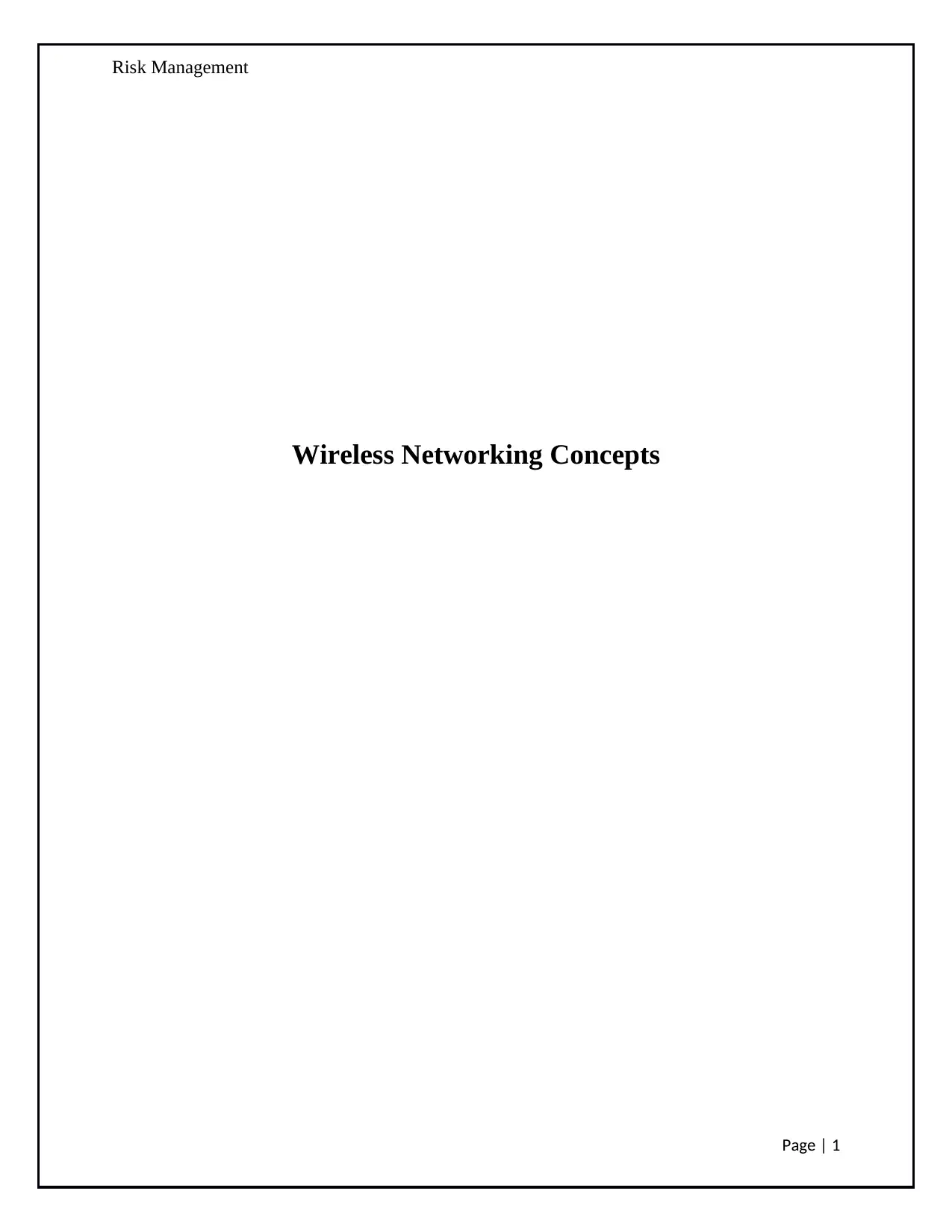
Risk Management
Wireless Networking Concepts
Page | 1
Wireless Networking Concepts
Page | 1
Secure Best Marks with AI Grader
Need help grading? Try our AI Grader for instant feedback on your assignments.
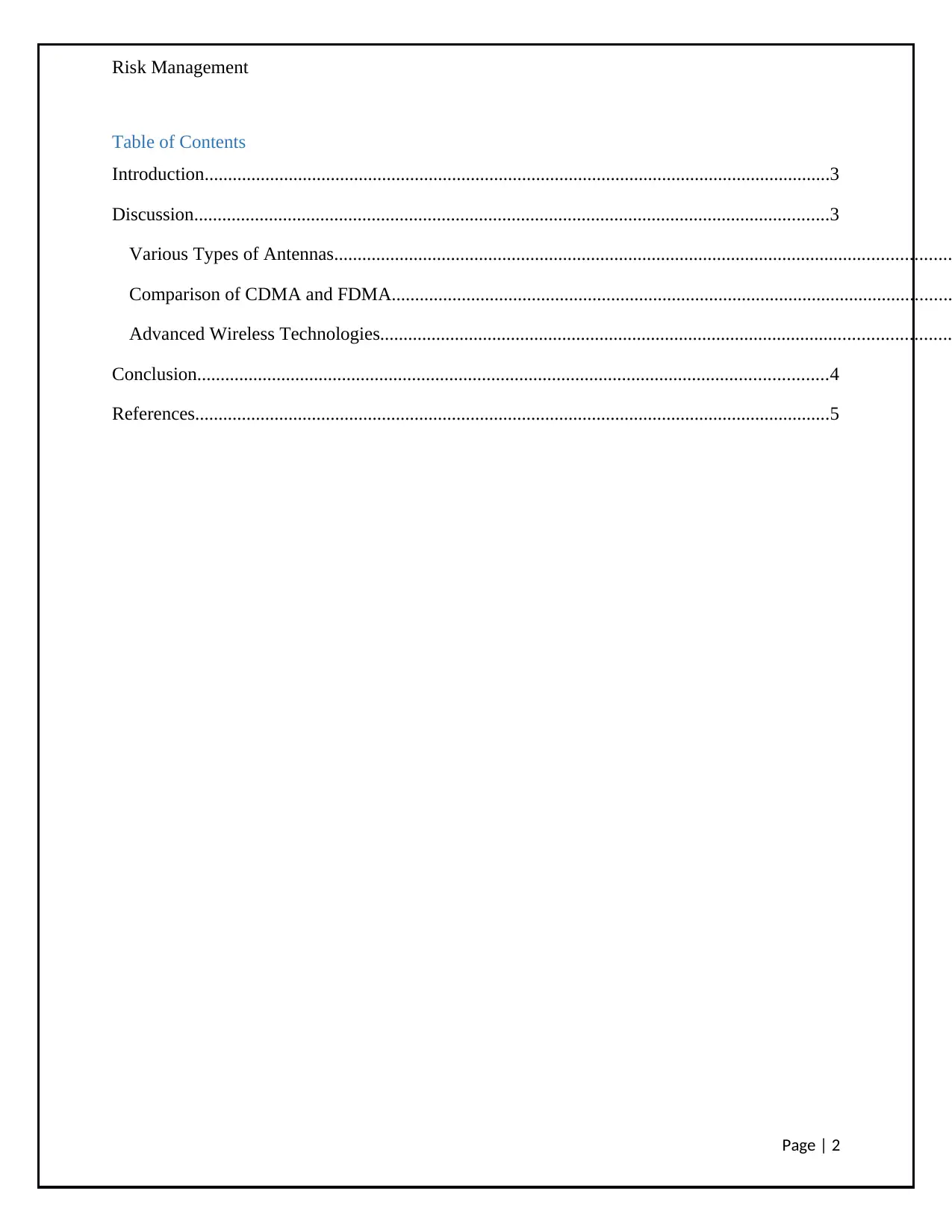
Risk Management
Table of Contents
Introduction......................................................................................................................................3
Discussion........................................................................................................................................3
Various Types of Antennas....................................................................................................................................
Comparison of CDMA and FDMA........................................................................................................................
Advanced Wireless Technologies..........................................................................................................................
Conclusion.......................................................................................................................................4
References........................................................................................................................................5
Page | 2
Table of Contents
Introduction......................................................................................................................................3
Discussion........................................................................................................................................3
Various Types of Antennas....................................................................................................................................
Comparison of CDMA and FDMA........................................................................................................................
Advanced Wireless Technologies..........................................................................................................................
Conclusion.......................................................................................................................................4
References........................................................................................................................................5
Page | 2
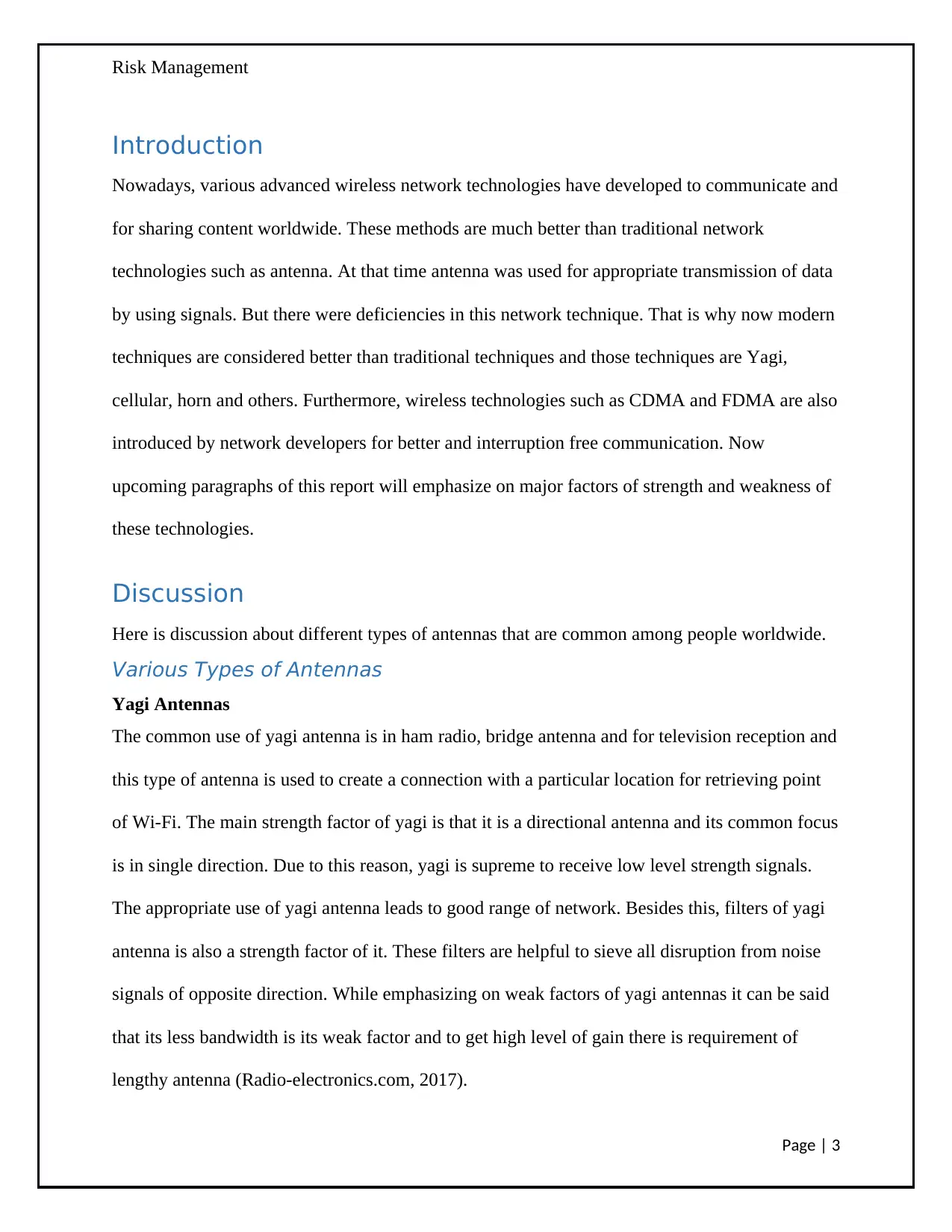
Risk Management
Introduction
Nowadays, various advanced wireless network technologies have developed to communicate and
for sharing content worldwide. These methods are much better than traditional network
technologies such as antenna. At that time antenna was used for appropriate transmission of data
by using signals. But there were deficiencies in this network technique. That is why now modern
techniques are considered better than traditional techniques and those techniques are Yagi,
cellular, horn and others. Furthermore, wireless technologies such as CDMA and FDMA are also
introduced by network developers for better and interruption free communication. Now
upcoming paragraphs of this report will emphasize on major factors of strength and weakness of
these technologies.
Discussion
Here is discussion about different types of antennas that are common among people worldwide.
Various Types of Antennas
Yagi Antennas
The common use of yagi antenna is in ham radio, bridge antenna and for television reception and
this type of antenna is used to create a connection with a particular location for retrieving point
of Wi-Fi. The main strength factor of yagi is that it is a directional antenna and its common focus
is in single direction. Due to this reason, yagi is supreme to receive low level strength signals.
The appropriate use of yagi antenna leads to good range of network. Besides this, filters of yagi
antenna is also a strength factor of it. These filters are helpful to sieve all disruption from noise
signals of opposite direction. While emphasizing on weak factors of yagi antennas it can be said
that its less bandwidth is its weak factor and to get high level of gain there is requirement of
lengthy antenna (Radio-electronics.com, 2017).
Page | 3
Introduction
Nowadays, various advanced wireless network technologies have developed to communicate and
for sharing content worldwide. These methods are much better than traditional network
technologies such as antenna. At that time antenna was used for appropriate transmission of data
by using signals. But there were deficiencies in this network technique. That is why now modern
techniques are considered better than traditional techniques and those techniques are Yagi,
cellular, horn and others. Furthermore, wireless technologies such as CDMA and FDMA are also
introduced by network developers for better and interruption free communication. Now
upcoming paragraphs of this report will emphasize on major factors of strength and weakness of
these technologies.
Discussion
Here is discussion about different types of antennas that are common among people worldwide.
Various Types of Antennas
Yagi Antennas
The common use of yagi antenna is in ham radio, bridge antenna and for television reception and
this type of antenna is used to create a connection with a particular location for retrieving point
of Wi-Fi. The main strength factor of yagi is that it is a directional antenna and its common focus
is in single direction. Due to this reason, yagi is supreme to receive low level strength signals.
The appropriate use of yagi antenna leads to good range of network. Besides this, filters of yagi
antenna is also a strength factor of it. These filters are helpful to sieve all disruption from noise
signals of opposite direction. While emphasizing on weak factors of yagi antennas it can be said
that its less bandwidth is its weak factor and to get high level of gain there is requirement of
lengthy antenna (Radio-electronics.com, 2017).
Page | 3
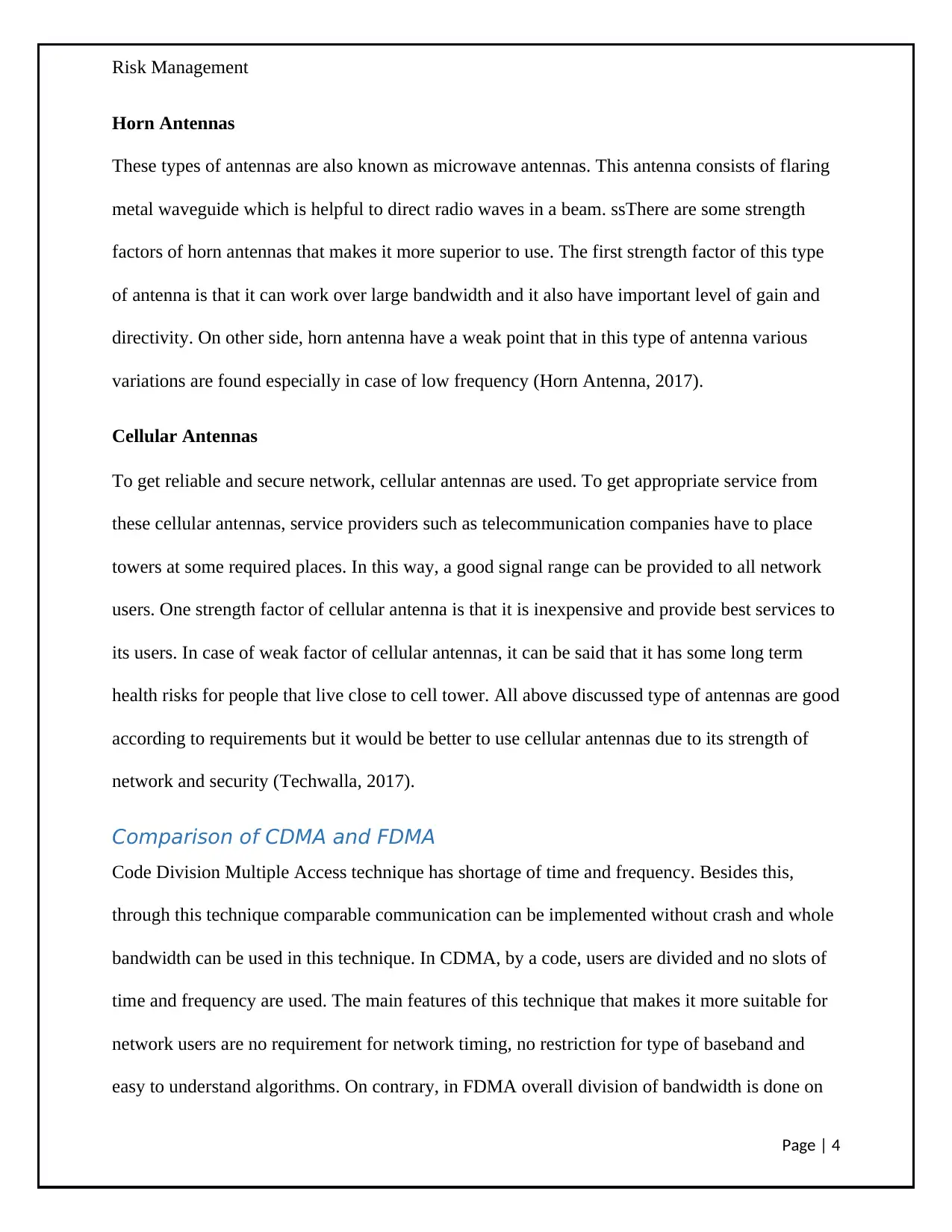
Risk Management
Horn Antennas
These types of antennas are also known as microwave antennas. This antenna consists of flaring
metal waveguide which is helpful to direct radio waves in a beam. ssThere are some strength
factors of horn antennas that makes it more superior to use. The first strength factor of this type
of antenna is that it can work over large bandwidth and it also have important level of gain and
directivity. On other side, horn antenna have a weak point that in this type of antenna various
variations are found especially in case of low frequency (Horn Antenna, 2017).
Cellular Antennas
To get reliable and secure network, cellular antennas are used. To get appropriate service from
these cellular antennas, service providers such as telecommunication companies have to place
towers at some required places. In this way, a good signal range can be provided to all network
users. One strength factor of cellular antenna is that it is inexpensive and provide best services to
its users. In case of weak factor of cellular antennas, it can be said that it has some long term
health risks for people that live close to cell tower. All above discussed type of antennas are good
according to requirements but it would be better to use cellular antennas due to its strength of
network and security (Techwalla, 2017).
Comparison of CDMA and FDMA
Code Division Multiple Access technique has shortage of time and frequency. Besides this,
through this technique comparable communication can be implemented without crash and whole
bandwidth can be used in this technique. In CDMA, by a code, users are divided and no slots of
time and frequency are used. The main features of this technique that makes it more suitable for
network users are no requirement for network timing, no restriction for type of baseband and
easy to understand algorithms. On contrary, in FDMA overall division of bandwidth is done on
Page | 4
Horn Antennas
These types of antennas are also known as microwave antennas. This antenna consists of flaring
metal waveguide which is helpful to direct radio waves in a beam. ssThere are some strength
factors of horn antennas that makes it more superior to use. The first strength factor of this type
of antenna is that it can work over large bandwidth and it also have important level of gain and
directivity. On other side, horn antenna have a weak point that in this type of antenna various
variations are found especially in case of low frequency (Horn Antenna, 2017).
Cellular Antennas
To get reliable and secure network, cellular antennas are used. To get appropriate service from
these cellular antennas, service providers such as telecommunication companies have to place
towers at some required places. In this way, a good signal range can be provided to all network
users. One strength factor of cellular antenna is that it is inexpensive and provide best services to
its users. In case of weak factor of cellular antennas, it can be said that it has some long term
health risks for people that live close to cell tower. All above discussed type of antennas are good
according to requirements but it would be better to use cellular antennas due to its strength of
network and security (Techwalla, 2017).
Comparison of CDMA and FDMA
Code Division Multiple Access technique has shortage of time and frequency. Besides this,
through this technique comparable communication can be implemented without crash and whole
bandwidth can be used in this technique. In CDMA, by a code, users are divided and no slots of
time and frequency are used. The main features of this technique that makes it more suitable for
network users are no requirement for network timing, no restriction for type of baseband and
easy to understand algorithms. On contrary, in FDMA overall division of bandwidth is done on
Page | 4
Secure Best Marks with AI Grader
Need help grading? Try our AI Grader for instant feedback on your assignments.
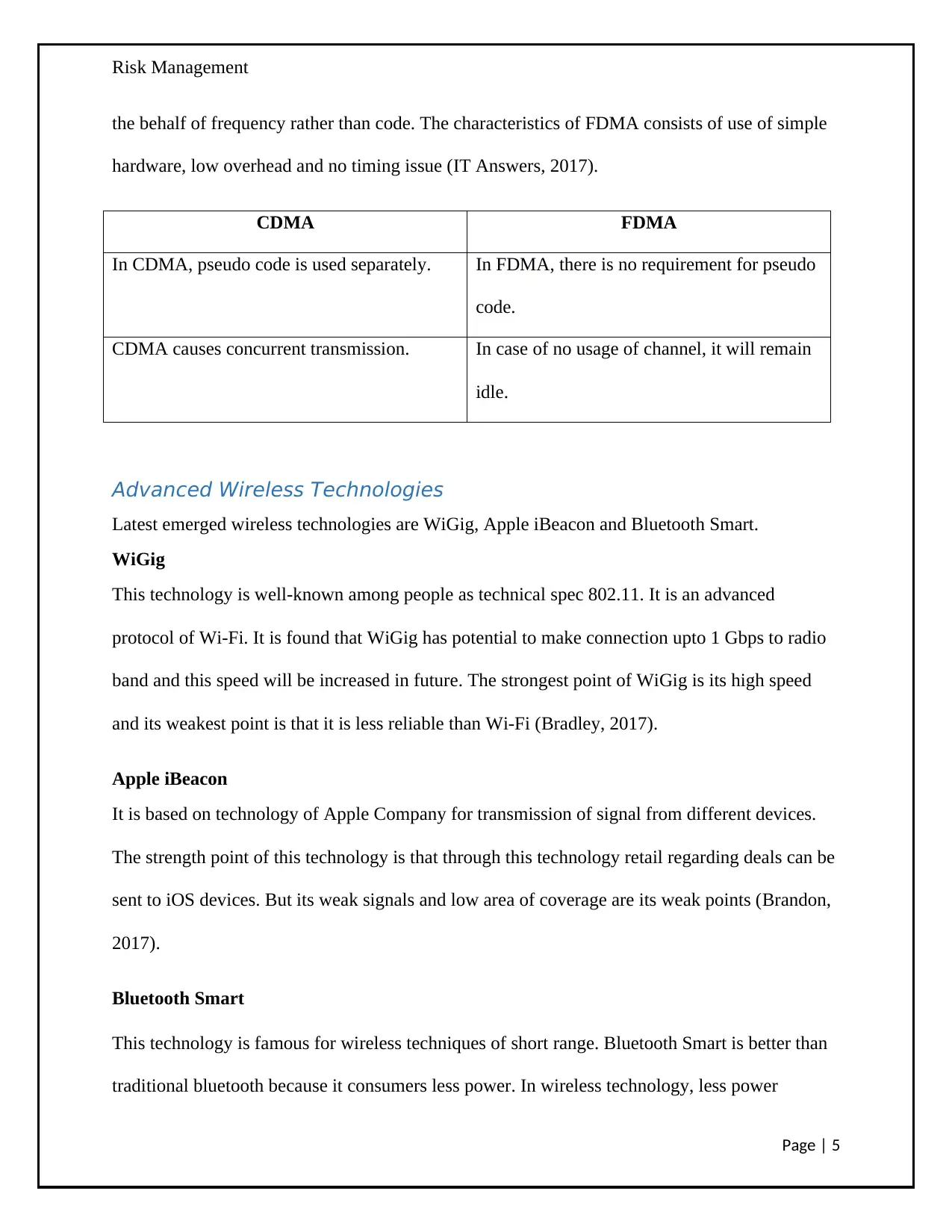
Risk Management
the behalf of frequency rather than code. The characteristics of FDMA consists of use of simple
hardware, low overhead and no timing issue (IT Answers, 2017).
CDMA FDMA
In CDMA, pseudo code is used separately. In FDMA, there is no requirement for pseudo
code.
CDMA causes concurrent transmission. In case of no usage of channel, it will remain
idle.
Advanced Wireless Technologies
Latest emerged wireless technologies are WiGig, Apple iBeacon and Bluetooth Smart.
WiGig
This technology is well-known among people as technical spec 802.11. It is an advanced
protocol of Wi-Fi. It is found that WiGig has potential to make connection upto 1 Gbps to radio
band and this speed will be increased in future. The strongest point of WiGig is its high speed
and its weakest point is that it is less reliable than Wi-Fi (Bradley, 2017).
Apple iBeacon
It is based on technology of Apple Company for transmission of signal from different devices.
The strength point of this technology is that through this technology retail regarding deals can be
sent to iOS devices. But its weak signals and low area of coverage are its weak points (Brandon,
2017).
Bluetooth Smart
This technology is famous for wireless techniques of short range. Bluetooth Smart is better than
traditional bluetooth because it consumers less power. In wireless technology, less power
Page | 5
the behalf of frequency rather than code. The characteristics of FDMA consists of use of simple
hardware, low overhead and no timing issue (IT Answers, 2017).
CDMA FDMA
In CDMA, pseudo code is used separately. In FDMA, there is no requirement for pseudo
code.
CDMA causes concurrent transmission. In case of no usage of channel, it will remain
idle.
Advanced Wireless Technologies
Latest emerged wireless technologies are WiGig, Apple iBeacon and Bluetooth Smart.
WiGig
This technology is well-known among people as technical spec 802.11. It is an advanced
protocol of Wi-Fi. It is found that WiGig has potential to make connection upto 1 Gbps to radio
band and this speed will be increased in future. The strongest point of WiGig is its high speed
and its weakest point is that it is less reliable than Wi-Fi (Bradley, 2017).
Apple iBeacon
It is based on technology of Apple Company for transmission of signal from different devices.
The strength point of this technology is that through this technology retail regarding deals can be
sent to iOS devices. But its weak signals and low area of coverage are its weak points (Brandon,
2017).
Bluetooth Smart
This technology is famous for wireless techniques of short range. Bluetooth Smart is better than
traditional bluetooth because it consumers less power. In wireless technology, less power
Page | 5
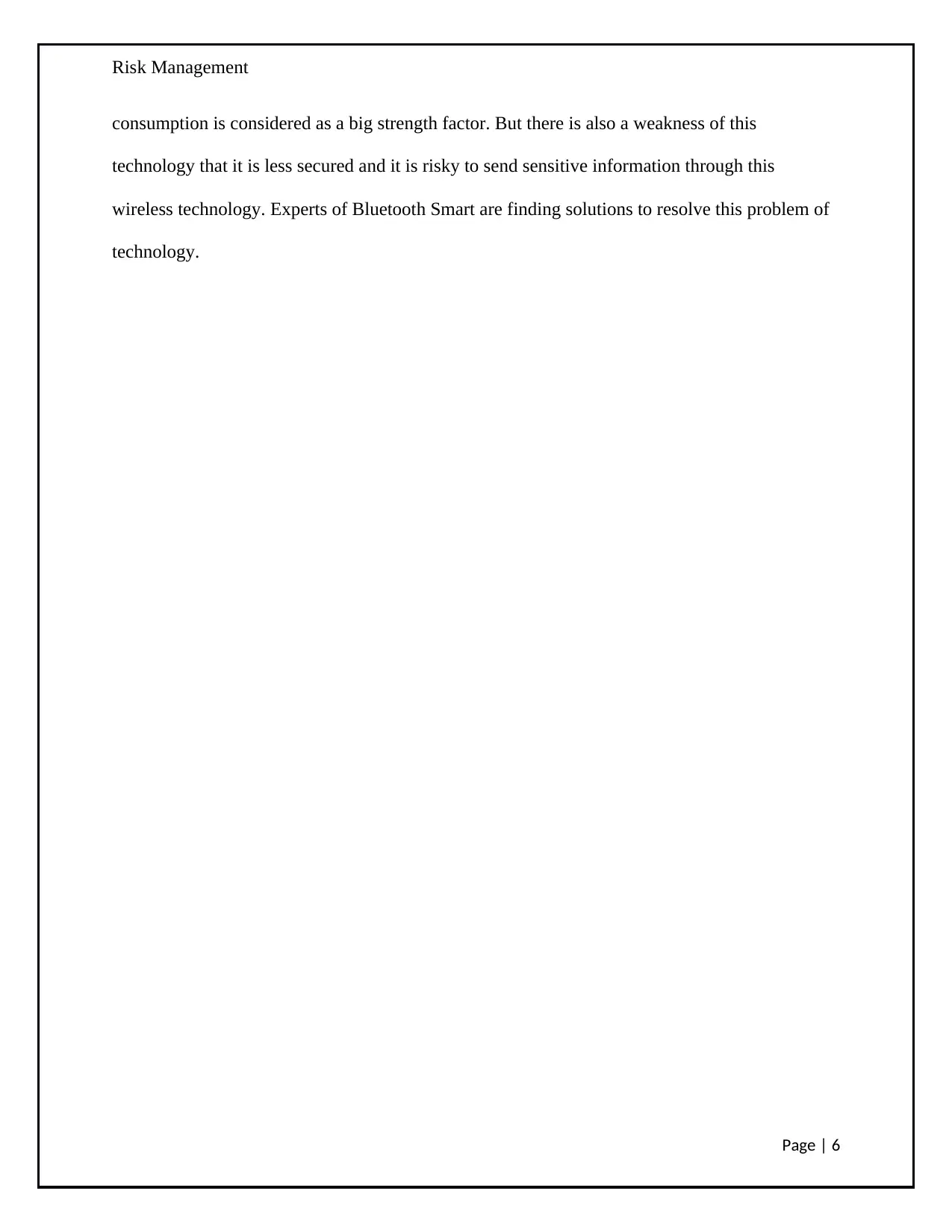
Risk Management
consumption is considered as a big strength factor. But there is also a weakness of this
technology that it is less secured and it is risky to send sensitive information through this
wireless technology. Experts of Bluetooth Smart are finding solutions to resolve this problem of
technology.
Page | 6
consumption is considered as a big strength factor. But there is also a weakness of this
technology that it is less secured and it is risky to send sensitive information through this
wireless technology. Experts of Bluetooth Smart are finding solutions to resolve this problem of
technology.
Page | 6
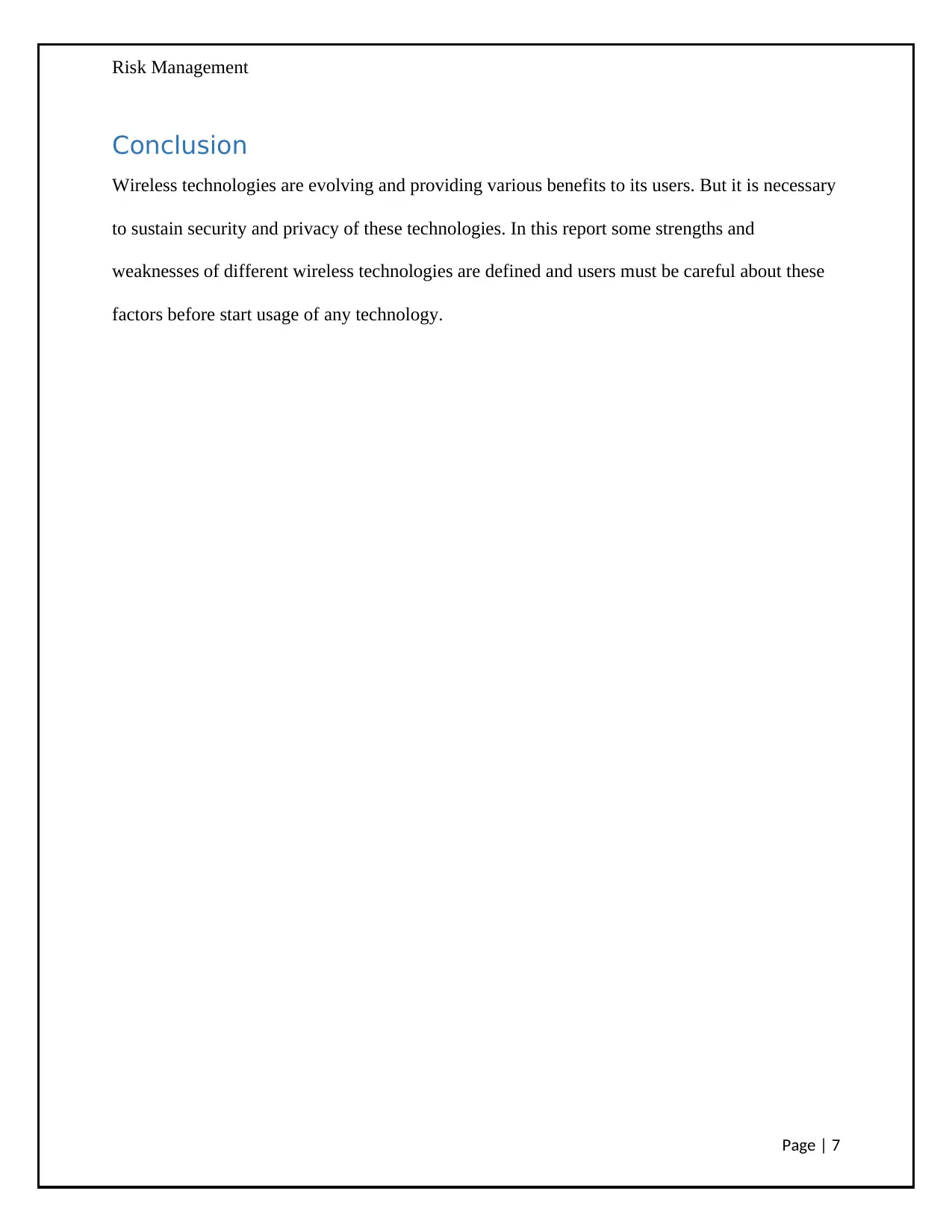
Risk Management
Conclusion
Wireless technologies are evolving and providing various benefits to its users. But it is necessary
to sustain security and privacy of these technologies. In this report some strengths and
weaknesses of different wireless technologies are defined and users must be careful about these
factors before start usage of any technology.
Page | 7
Conclusion
Wireless technologies are evolving and providing various benefits to its users. But it is necessary
to sustain security and privacy of these technologies. In this report some strengths and
weaknesses of different wireless technologies are defined and users must be careful about these
factors before start usage of any technology.
Page | 7
Paraphrase This Document
Need a fresh take? Get an instant paraphrase of this document with our AI Paraphraser
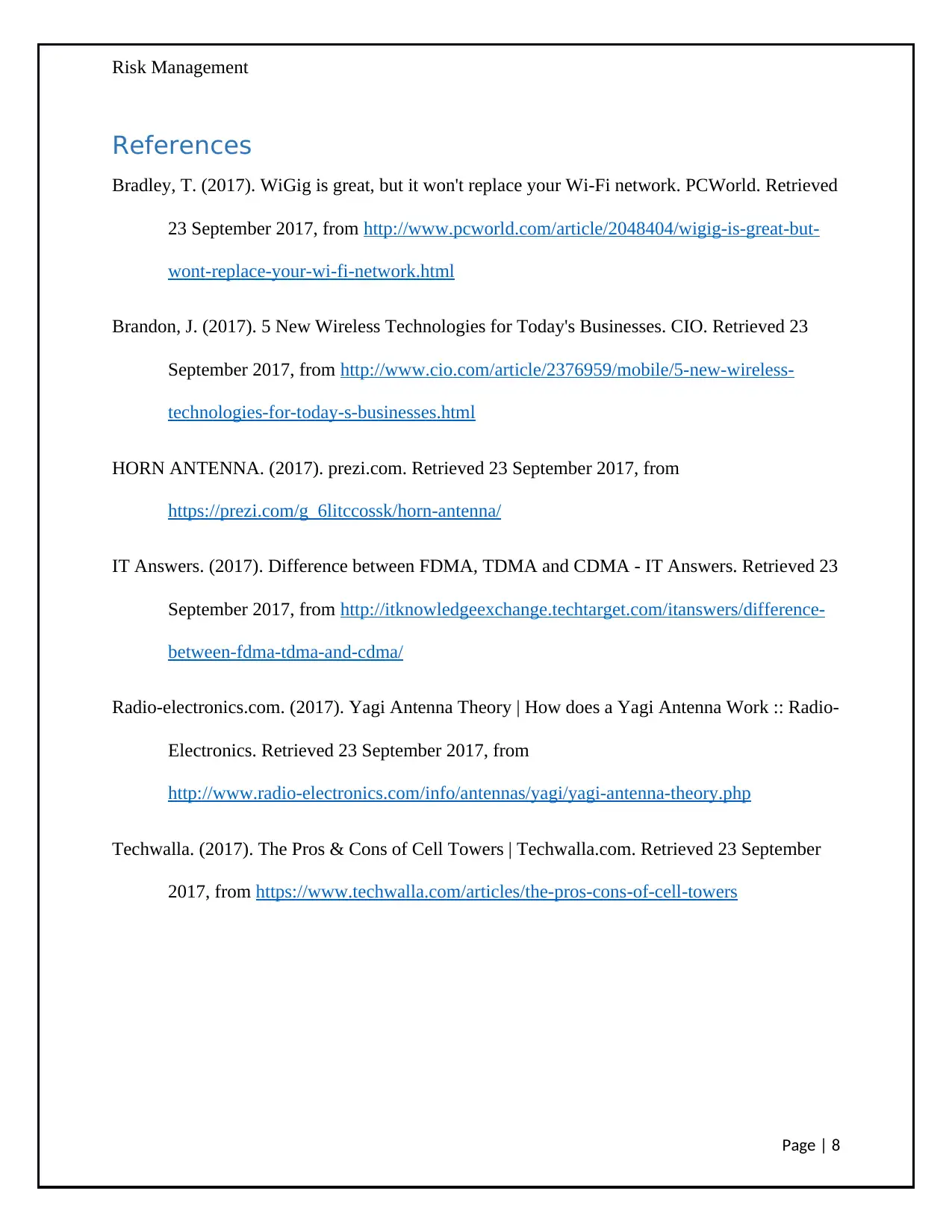
Risk Management
References
Bradley, T. (2017). WiGig is great, but it won't replace your Wi-Fi network. PCWorld. Retrieved
23 September 2017, from http://www.pcworld.com/article/2048404/wigig-is-great-but-
wont-replace-your-wi-fi-network.html
Brandon, J. (2017). 5 New Wireless Technologies for Today's Businesses. CIO. Retrieved 23
September 2017, from http://www.cio.com/article/2376959/mobile/5-new-wireless-
technologies-for-today-s-businesses.html
HORN ANTENNA. (2017). prezi.com. Retrieved 23 September 2017, from
https://prezi.com/g_6litccossk/horn-antenna/
IT Answers. (2017). Difference between FDMA, TDMA and CDMA - IT Answers. Retrieved 23
September 2017, from http://itknowledgeexchange.techtarget.com/itanswers/difference-
between-fdma-tdma-and-cdma/
Radio-electronics.com. (2017). Yagi Antenna Theory | How does a Yagi Antenna Work :: Radio-
Electronics. Retrieved 23 September 2017, from
http://www.radio-electronics.com/info/antennas/yagi/yagi-antenna-theory.php
Techwalla. (2017). The Pros & Cons of Cell Towers | Techwalla.com. Retrieved 23 September
2017, from https://www.techwalla.com/articles/the-pros-cons-of-cell-towers
Page | 8
References
Bradley, T. (2017). WiGig is great, but it won't replace your Wi-Fi network. PCWorld. Retrieved
23 September 2017, from http://www.pcworld.com/article/2048404/wigig-is-great-but-
wont-replace-your-wi-fi-network.html
Brandon, J. (2017). 5 New Wireless Technologies for Today's Businesses. CIO. Retrieved 23
September 2017, from http://www.cio.com/article/2376959/mobile/5-new-wireless-
technologies-for-today-s-businesses.html
HORN ANTENNA. (2017). prezi.com. Retrieved 23 September 2017, from
https://prezi.com/g_6litccossk/horn-antenna/
IT Answers. (2017). Difference between FDMA, TDMA and CDMA - IT Answers. Retrieved 23
September 2017, from http://itknowledgeexchange.techtarget.com/itanswers/difference-
between-fdma-tdma-and-cdma/
Radio-electronics.com. (2017). Yagi Antenna Theory | How does a Yagi Antenna Work :: Radio-
Electronics. Retrieved 23 September 2017, from
http://www.radio-electronics.com/info/antennas/yagi/yagi-antenna-theory.php
Techwalla. (2017). The Pros & Cons of Cell Towers | Techwalla.com. Retrieved 23 September
2017, from https://www.techwalla.com/articles/the-pros-cons-of-cell-towers
Page | 8
1 out of 8
Related Documents
Your All-in-One AI-Powered Toolkit for Academic Success.
+13062052269
info@desklib.com
Available 24*7 on WhatsApp / Email
![[object Object]](/_next/static/media/star-bottom.7253800d.svg)
Unlock your academic potential
© 2024 | Zucol Services PVT LTD | All rights reserved.





